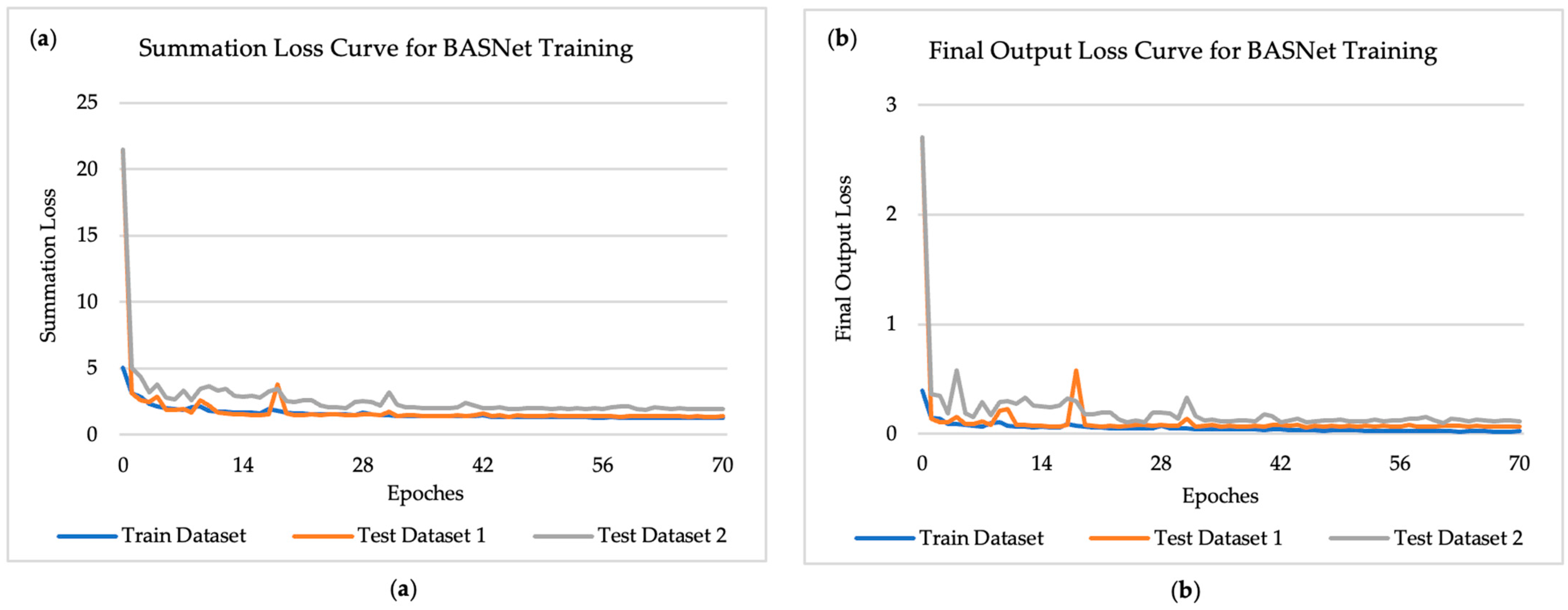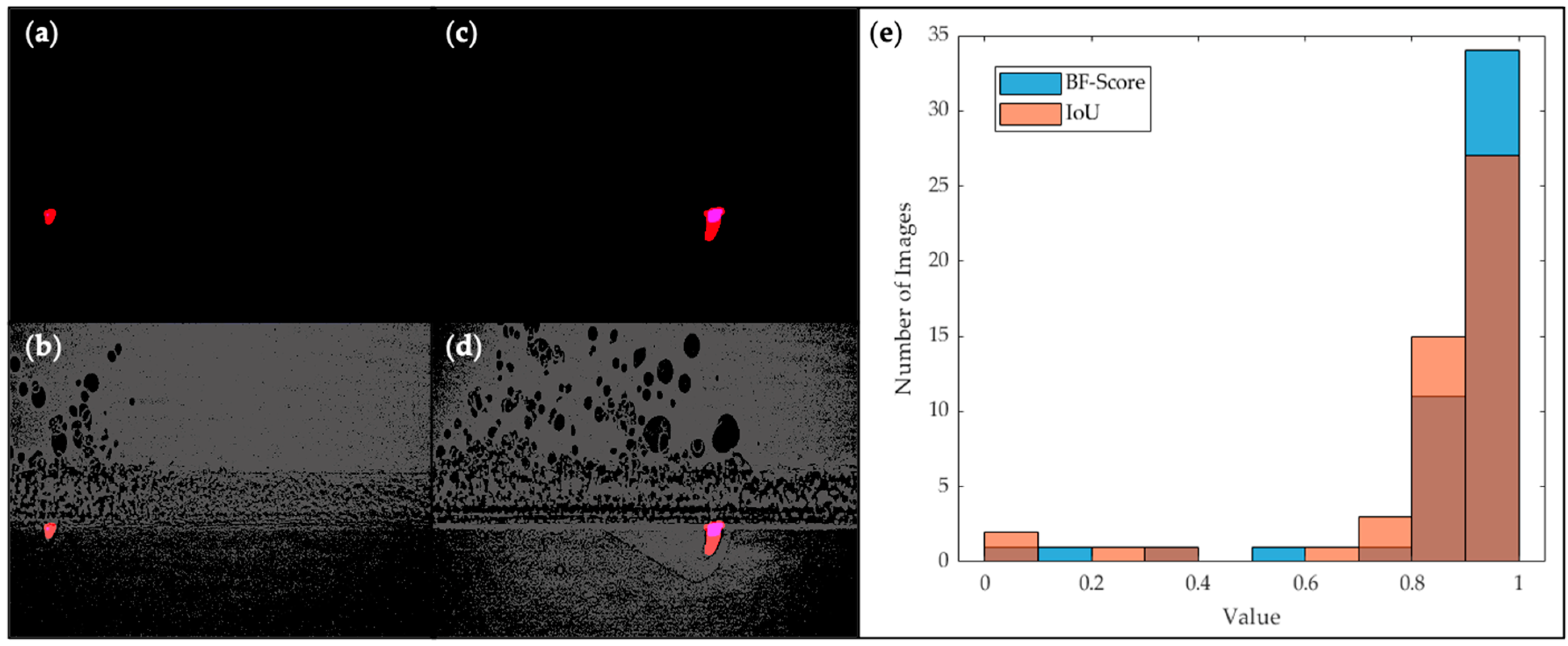Deep-Learning-Based Segmentation of Keyhole in In-Situ X-ray Imaging of Laser Powder Bed Fusion
Abstract
1. Introduction
2. Methods
2.1. Raw Images
2.2. Filtering
2.3. Segmentation Network Training
2.4. Deep Learning Segmentation on Test Data
3. Results
3.1. Training and Loss Function
3.2. Testing and Performance Matrices
4. Discussion
5. Conclusions
Supplementary Materials
Author Contributions
Funding
Institutional Review Board Statement
Informed Consent Statement
Data Availability Statement
Acknowledgments
Conflicts of Interest
References
- Chowdhury, S.; Yadaiah, N.; Prakash, C.; Ramakrishna, S.; Dixit, S.; Gupta, L.R.; Buddhi, D. Laser Powder Bed Fusion: A State-of-the-Art Review of the Technology, Materials, Properties & Defects, and Numerical Modelling. J. Mater. Res. Technol. 2022, 20, 2109–2172. [Google Scholar] [CrossRef]
- Abd-Elaziem, W.; Elkatatny, S.; Abd-Elaziem, A.-E.; Khedr, M.; Abd El-baky, M.A.; Hassan, M.A.; Abu-Okail, M.; Mohammed, M.; Järvenpää, A.; Allam, T.; et al. On the Current Research Progress of Metallic Materials Fabricated by Laser Powder Bed Fusion Process: A Review. J. Mater. Res. Technol. 2022, 20, 681–707. [Google Scholar] [CrossRef]
- Dev Singh, D.; Mahender, T.; Raji Reddy, A. Powder Bed Fusion Process: A Brief Review. Mater Today Proc. 2021, 46, 350–355. [Google Scholar] [CrossRef]
- Zhao, C.; Parab, N.D.; Li, X.; Fezzaa, K.; Tan, W.; Rollett, A.D.; Sun, T. Critical Instability at Moving Keyhole Tip Generates Porosity in Laser Melting. Science 1979 2020, 370, 1080–1086. [Google Scholar] [CrossRef] [PubMed]
- Martin, A.A.; Calta, N.P.; Hammons, J.A.; Khairallah, S.A.; Nielsen, M.H.; Shuttlesworth, R.M.; Sinclair, N.; Matthews, M.J.; Jeffries, J.R.; Willey, T.M.; et al. Ultrafast Dynamics of Laser-Metal Interactions in Additive Manufacturing Alloys Captured by in Situ X-Ray Imaging. Mater. Today Adv. 2019, 1, 100002. [Google Scholar] [CrossRef]
- Zhang, Y.; Zhang, J. Modeling of Solidification Microstructure Evolution in Laser Powder Bed Fusion Fabricated 316L Stainless Steel Using Combined Computational Fluid Dynamics and Cellular Automata. Addit. Manuf. 2019, 28, 750–765. [Google Scholar] [CrossRef]
- Alphonso, W.E.; Baier, M.; Carmignato, S.; Hattel, J.H.; Bayat, M. On the Possibility of Doing Reduced Order, Thermo-Fluid Modelling of Laser Powder Bed Fusion (L-PBF)—Assessment of the Importance of Recoil Pressure and Surface Tension. J. Manuf. Process. 2023, 94, 564–577. [Google Scholar] [CrossRef]
- Qu, M.; Guo, Q.; Escano, L.I.; Clark, S.J.; Fezzaa, K.; Chen, L. Mitigating Keyhole Pore Formation by Nanoparticles during Laser Powder Bed Fusion Additive Manufacturing. Addit. Manuf. Lett. 2022, 3, 100068. [Google Scholar] [CrossRef]
- Wang, L.; Zhang, Y.; Chia, H.Y.; Yan, W. Mechanism of Keyhole Pore Formation in Metal Additive Manufacturing. NPJ Comput. Mater. 2022, 8, 22. [Google Scholar] [CrossRef]
- Bayat, M.; Thanki, A.; Mohanty, S.; Witvrouw, A.; Yang, S.; Thorborg, J.; Tiedje, N.S.; Hattel, J.H. Keyhole-Induced Porosities in Laser-Based Powder Bed Fusion (L-PBF) of Ti6Al4V: High-Fidelity Modelling and Experimental Validation. Addit. Manuf. 2019, 30, 100835. [Google Scholar] [CrossRef]
- Chen, L.; Yao, X.; Tan, C.; He, W.; Su, J.; Weng, F.; Chew, Y.; Ng, N.P.H.; Moon, S.K. In-Situ Crack and Keyhole Pore Detection in Laser Directed Energy Deposition through Acoustic Signal and Deep Learning. Addit. Manuf. 2023, 69, 103547. [Google Scholar] [CrossRef]
- Ren, Z.; Gao, L.; Clark, S.J.; Fezzaa, K.; Shevchenko, P.; Choi, A.; Everhart, W.; Rollett, A.D.; Chen, L.; Sun, T. Machine Learning–Aided Real-Time Detection of Keyhole Pore Generation in Laser Powder Bed Fusion. Science 1979 2023, 379, 89–94. [Google Scholar] [CrossRef] [PubMed]
- Pyeon, J.; Aroh, J.; Jiang, R.; Verma, A.K.; Gould, B.; Ramlatchan, A.; Fezzaa, K.; Parab, N.; Zhao, C.; Sun, T.; et al. Time-Resolved Geometric Feature Tracking Elucidates Laser-Induced Keyhole Dynamics. Integr. Mater. Manuf. Innov. 2021, 10, 677–688. [Google Scholar] [CrossRef]
- Zhang, J.; Lyu, T.; Hua, Y.; Shen, Z.; Sun, Q.; Rong, Y.; Zou, Y. Image Segmentation for Defect Analysis in Laser Powder Bed Fusion: Deep Data Mining of X-Ray Photography from Recent Literature. Integr. Mater. Manuf. Innov. 2022, 11, 418–432. [Google Scholar] [CrossRef]
- Qin, X.; Fan, D.-P.; Huang, C.; Diagne, C.; Zhang, Z.; Sant’Anna, A.C.; Suàrez, A.; Jägersand, M.; Shao, L. Boundary-Aware Segmentation Network for Mobile and Web Applications. arXiv 2021, arXiv:2101.04704. [Google Scholar]
- Csurka, G.; Larlus, D.; Perronnin, F. What Is a Good Evaluation Measure for Semantic Segmentation? In Proceedings of the British Machine Vision Conference, Bristol, UK, 9–13 September 2013; Burghardt, T., Damen, D., Mayol-Cuevas, W., Mirmehdi, M., Eds.; Visual Information Laboriatory (VIL): Bristol, UK, 2013; pp. 32.1–32.11. [Google Scholar]
- Chen, L.-C.; Zhu, Y.; Papandreou, G.; Schroff, F.; Adam, H. Encoder-Decoder with Atrous Separable Convolution for Semantic Image Segmentation. In Proceedings of the Computer Vision—ECCV 2018, Munich, Germany, 8–14 September 2018; Ferrari, V., Hebert, M., Sminchisescu, C., Weiss, Y., Eds.; Springer International Publishing: Cham, Switzerland, 2018; pp. 833–851. [Google Scholar]
- Ronneberger, O.; Fischer, P.; Brox, T. U-Net: Convolutional Networks for Biomedical Image Segmentation. In Proceedings of the Medical Image Computing and Computer-Assisted Intervention—MICCAI 2015, Munich, Germany, 5–9 October 2015; Navab, N., Hornegger, J., Wells, W.M., Frangi, A.F., Eds.; Springer International Publishing: Cham, Switzerland, 2015; pp. 234–241. [Google Scholar]






| Experiment | Material | Nanoparticle | Substrate | Power (W) | Scan Speed (m/s) |
|---|---|---|---|---|---|
| 1 | Al6061 | 10%vol TiC | Printed | 385 | 0.3 |
| 2 | Al6061 | 10%vol TiC | Printed | 385 | 0.4 |
| 3 | Al6061 | / | Printed | 443 | 0.4 |
| 4 | Al6061 | / | As-cast | 500 | 0.2 |
| 5 | Al6061 | / | Printed | 500 | 0.4 |
| 6 | Al6061 | / | As-cast | 500 | 0.4 |
| 7 | Al6061 | / | As-cast | 500 | 0.4 |
| 8 | AlSi10Mg | / | As-cast | 500 | 0.5 |
| Run | Testing Dataset | IoU | BF-Score |
|---|---|---|---|
| 1 | 1 | 0.9381 | 0.9514 |
| 1 | 2 | 0.8923 | 0.9098 |
| 2 | 3 | 0.8333 | 0.8603 |
| 2 | 4 | 0.9321 | 0.9421 |
| 3 | 5 | 0.9195 | 0.9352 |
| 3 | 6 | 0.9190 | 0.9351 |
| 4 | 7 | 0.9130 | 0.9313 |
| 4 | 8 | 0.9518 | 0.9595 |
| Average | 0.9124 | 0.9281 |
| Run | Dataset 1 and 2 | Dataset 3 and 4 | Dataset 5 and 6 | Dataset 7 and 8 |
|---|---|---|---|---|
| 1 | Test | Train | Train | Train |
| 2 | Train | Test | Train | Train |
| 3 | Train | Train | Test | Train |
| 4 | Train | Train | Train | Test |
| Dataset | Average Brightness | Average Contrast | ||||
|---|---|---|---|---|---|---|
| Raw | Subtracted | Binarized | Raw | Subtracted | Binarized | |
| 1 | 0.5852 | 0.0079 | 0.0363 | 0.8034 | 0.4820 | 1.0000 |
| 2 | 0.5802 | 0.0091 | 0.0374 | 0.7496 | 0.4958 | 1.0000 |
| 3 | 0.0131 | 0.0001 | 0.0314 | 0.0278 | 0.0155 | 1.0000 |
| 4 | 0.0113 | 0.0001 | 0.0275 | 0.0255 | 0.0129 | 1.0000 |
| 5 | 0.0131 | 0.0001 | 0.0328 | 0.0288 | 0.0156 | 1.0000 |
| 6 | 0.5841 | 0.0097 | 0.0350 | 0.7833 | 0.5260 | 1.0000 |
| 7 | 0.0115 | 0.0001 | 0.0215 | 0.0264 | 0.0119 | 1.0000 |
| 8 | 0.5876 | 0.0083 | 0.0389 | 0.7503 | 0.4261 | 1.0000 |
Disclaimer/Publisher’s Note: The statements, opinions and data contained in all publications are solely those of the individual author(s) and contributor(s) and not of MDPI and/or the editor(s). MDPI and/or the editor(s) disclaim responsibility for any injury to people or property resulting from any ideas, methods, instructions or products referred to in the content. |
© 2024 by the authors. Licensee MDPI, Basel, Switzerland. This article is an open access article distributed under the terms and conditions of the Creative Commons Attribution (CC BY) license (https://creativecommons.org/licenses/by/4.0/).
Share and Cite
Dong, W.; Lian, J.; Yan, C.; Zhong, Y.; Karnati, S.; Guo, Q.; Chen, L.; Morgan, D. Deep-Learning-Based Segmentation of Keyhole in In-Situ X-ray Imaging of Laser Powder Bed Fusion. Materials 2024, 17, 510. https://doi.org/10.3390/ma17020510
Dong W, Lian J, Yan C, Zhong Y, Karnati S, Guo Q, Chen L, Morgan D. Deep-Learning-Based Segmentation of Keyhole in In-Situ X-ray Imaging of Laser Powder Bed Fusion. Materials. 2024; 17(2):510. https://doi.org/10.3390/ma17020510
Chicago/Turabian StyleDong, William, Jason Lian, Chengpo Yan, Yiran Zhong, Sumanth Karnati, Qilin Guo, Lianyi Chen, and Dane Morgan. 2024. "Deep-Learning-Based Segmentation of Keyhole in In-Situ X-ray Imaging of Laser Powder Bed Fusion" Materials 17, no. 2: 510. https://doi.org/10.3390/ma17020510
APA StyleDong, W., Lian, J., Yan, C., Zhong, Y., Karnati, S., Guo, Q., Chen, L., & Morgan, D. (2024). Deep-Learning-Based Segmentation of Keyhole in In-Situ X-ray Imaging of Laser Powder Bed Fusion. Materials, 17(2), 510. https://doi.org/10.3390/ma17020510








